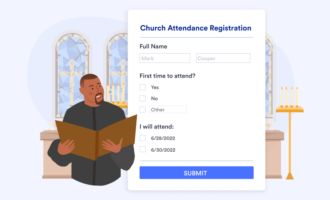Top church survey questions
- How well do you understand the mission of the church?
- Do you feel the church is sensitive to the needs of members?
- How satisfied are you as a member of our church?
- What’s one thing we could do to better achieve our mission?
- What do you enjoy most about attending services here?
- Do you feel the church welcomes new members and guests?
- Would you recommend this church to friends or family?
- What three words would you use to describe our church?
- Do you feel connected with and supported by church leaders?
- Do you feel like you’re in the know about what’s happening at our church?
- Do you feel the church provides you with opportunities for spiritual growth?
Churches should meet the spiritual needs of their congregations, but it can be hard to keep track of what church members are hoping for and need from their church. Checking in with your congregation is a great way to evaluate how you’re currently doing and see if there are things you could do better to meet church members where they’re at.
Distributing an online survey is a great way to collect honest feedback — especially if you make the survey anonymous. By asking useful and specific church survey questions, you can get valuable input from members that can help you boost attendance, engagement, and a sense of community.
Skip the intro, show me the types of church survey questions to ask.
Why church survey questions are important
Church survey questions gather insights and feedback directly from your congregation. They help church leaders understand the preferences, concerns, and needs of members. Questions can cover a wide range of topics, from worship service experiences to the effectiveness of your local outreach efforts.
The data you gather can include quantitative insights that capture overall impressions of the church and qualitative information that encompasses people’s personal thoughts and reactions.
Anonymous surveys are the best way to go — people are more likely to be honest in their responses and less likely to feel social pressure or worry about being judged. Honest survey responses can help church leaders better understand where to direct their efforts and identify possible problem areas.
The benefits of asking church survey questions
Getting real feedback in any endeavor is always important. But it’s especially important for churches because churches themselves are especially important to people — people bring their most personal and vulnerable needs to church in search of spiritual solace and community support. It’s vital to keep communication honest and open to foster safety and belonging.
Pastors, church leaders, and ministry teams can benefit from church survey questions because surveys create an open dialogue with your congregation and highlight areas of strength and areas of greater need. Church members can also benefit from survey questions by seeing that their thoughts and feedback are acknowledged and shape the church’s direction.
A better understanding of the state of your church can enhance future worship services, improve church programs, and forge stronger connections in the community.
Create a church survey preloaded with these 18 questions.
Types of church survey questions to ask
The types of church survey questions you should ask depend on your goals for the survey. Are you hoping to increase attendance? Are you trying to get members more involved? Are you looking for general community feedback before starting a church? Ultimately, the questions you include in your survey should provide input that helps you achieve your goals.
If you don’t know where to start, we’ve included 18 church survey questions here that can provide some inspiration. You can also take a look at one of Jotform’s 600-plus church form templates, including guest questionnaires and prayer request forms, and easily get started creating your survey with Jotform’s free online survey maker.
Church survey questions to gauge overall experience
Your congregation should be passionate about your church’s mission and feel like they’re personally connected to it — these are the keys to sustained engagement. So it’s a good idea to ask questions about the mission and congregants’ relationship to it.
- How well do you understand the mission of the church?
- This question gauges church members’ understanding of the mission and, relatedly, church leadership’s messaging around it. You can ask anyone, from newbies to veterans, this question at any time. You could use a rating scale question format (with answers ranging from “Not at all” to “Completely”), or ask it as an open-ended question to get more detailed and personal feedback.
- Do you feel the church is sensitive to the needs of members?
- This gives you insight into how well the church addresses and responds to the congregation’s needs. It’s best to ask this question during regular member check-ins or after major church initiatives and events. The answers to this question can be personal and specific, so combining a rating scale or yes/no question with an open-ended question format might be a good idea.
- How satisfied are you as a member of our church?
- This question measures overall member satisfaction. It’s ideal when you’re conducting annual surveys or after you’ve made significant changes within the church. Respondents can rank satisfaction on a scale of 1–10, with 1 being “Not at all” and 10 being “Very.”
- What’s one thing we could do to better achieve our mission?
- This is a way to encourage members to provide constructive feedback and ideas. You could ask this question in periodic surveys or during evaluation periods. An open-ended question format lets the congregation share detailed suggestions.
Church survey questions to increase attendance
It’s important to understand why members enjoy attending services at your church and to pinpoint areas for improvement. Ask questions focused on how people feel when they attend and how they’d describe the environment.
- What do you enjoy most about attending services here?
- This will help you identify what resonates with members so you can understand your strengths. This question works well when you’re conducting regular checkup surveys or when you want to see how people are responding to any new elements you may have added to a service. Open-ended questions are best here.
- What is the biggest reason you’re likely to miss church service?
- This will reveal common barriers to attendance and see if any of them are resolvable — for example, if people need help with transportation. You can ask this question periodically or when you notice a drop in attendance. Include multiple-choice answer options, like lack of time, health reasons, transportation, etc., and a fill-in-the-blank field for people to provide their own answers.
- Do you feel the church welcomes new members and guests?
- This question invites members to evaluate the church’s hospitality and inclusivity. It’s suited for surveys after large events or initiatives that targeted new members. Try a Likert scale question format, with answers ranging from “Strongly disagree” to “Strongly agree.”
- Is there anything we can do to make our church feel more welcoming for new visitors?
- This question can help you gather ideas for improving the environment to ensure it’s more welcoming and hospitable. It’s best to ask this question after events with new members or efforts to capture new members. Use an open-ended question format.
- Would you recommend this church to friends or family?
- You can track member satisfaction with the church in general with this question. It’s perfect for post-service surveys or annual feedback surveys. Consider using a yes/no format with an open-ended follow-up question to ask “Why or why not?”
- What three words would you use to describe our church?
- This captures the church’s perceived identity and values from the congregation’s viewpoint. It’s best to ask this question when you’re reevaluating or refining the church’s messaging. Use an open-ended format.
- If you’ve attended a different church in the past year, was there anything you enjoyed about that church that’s different from ours?
- The answers to this question will provide insight into what other churches and services are offering. It’s an effective question to pose during member feedback sessions after visits to other churches. It requires an open-ended format to give respondents the space to describe the differences.
Church survey questions to build community
Community is core to the mission of a church, and to why people come to it. If you want to get your congregation more involved in church events and volunteering, try asking these questions.
- Do you feel connected with and supported by church leaders?
- This question can help you assess the level of support and connection members feel from church leaders. You can ask this question on a periodic basis or after leadership changes. You can use a Likert scale format, with answers ranging from “Strongly disagree” to “Strongly agree,” to easily spot trends in the congregation’s feelings. An open-ended follow-up field will also be useful.
- Do you feel like other members of the church and the ministry value your contributions?
- This can reveal whether members feel their efforts and thoughts are appreciated. You can ask this question in surveys you conduct annually or after large team projects. Consider using a Likert scale of agreement.
- Do you feel like you’re in the know about what’s happening at our church?
- This is a great way to track whether your communication is effective. It’s best to ask this one regularly or before important events. You can use a Likert scale, with answers ranging from “Strongly disagree” to “Strongly agree.”
- Do you receive all the information you need regarding church projects and events?
- This question can help you determine whether members are aware of upcoming events and whether your current communication methods are reaching everyone. It’s ideal after major projects, initiatives, and events. Stick to the Likert scale here too.
- What methods of communication do you prefer for receiving updates and news?
- This is a great way to learn about people’s preferred channels for contact and information. It slots in well during any period of communication strategy evaluation or after a major miscommunication. You can use multiple-choice or checkbox question formats.
- Do you feel the church provides you with opportunities for spiritual growth?
- Meeting people’s spiritual needs is essential for a church. This question lets you check in about how you’re doing and see if church members have ideas or thoughts about how you can serve people better. This question is very important and should be asked regularly. You can use a yes/no question format with an open-ended follow-up field.
- Have you volunteered in the past year? If not, what’s the biggest reason why?
- This question evaluates volunteer participation and uncovers barriers to involvement. It fits well on annual surveys or after large volunteer drives. It’s best with a yes/no format and a follow-up multiple-choice question that lists options for why people may not have volunteered, like lack of time, lack of awareness of volunteering opportunities, etc. You can also include a fill-in-the-blank answer option.
Tips for conducting church survey questions
You should keep questions clear and concise to ensure accurate responses. Anonymity is also key if you want honest answers. You can use a mix of question formats, including rating scales, multiple-choice, and open-ended, to gather both quantitative data that highlights broad trends and general sentiments and qualitative data that contains personal responses and thoughts.
After conducting a survey, leadership should review its findings together. Celebrate things that you’re doing well, and develop follow-up plans for addressing any issues that were raised. If you implement changes, communicate them to the congregation so they know their feedback matters.
Things to avoid when conducting church survey questions
Avoid ambiguously worded or leading questions. Both are primary drivers of skewed results. Remember to keep things simple. Don’t use technical or complex language in your surveys.
It’s also best not to overload surveys with too many questions; otherwise, members may give up halfway through or just avoid the survey entirely after a quick glance.
Other things to consider when creating a church survey
To make your survey as effective as possible, follow these guidelines.
- Keep the survey brief. A survey with 30-plus questions will likely have a low response rate. Aim for 5–15 questions for the best completion rate.
- Make sure your questions are clear. If you include rating scales, indicate what the high and low numbers represent so there’s no confusion — for example, “On a scale of 1–10, with 1 being poor and 10 being excellent, please rate your experience.”
- Add a space for additional comments. Consider leaving an open comment field at the end of the survey for optional feedback. Some people have a lot to say, so provide them an opportunity to share their thoughts.
- Test your survey on multiple devices. It should work on mobile devices and desktop computers. Depending on what tool you use, you may need to tinker with settings to ensure your survey looks right on any device. Jotform offers mobile-responsive surveys, so you don’t have to worry about formatting for different devices.
Jotform: The easy and effective way to ask church survey questions and analyze results
Creating a church survey is easy when you have the right tools. With Jotform, you can choose from hundreds of free church form templates or create your own survey from scratch in just minutes. Use Jotform’s drag-and-drop Form Builder to add or remove questions, change fonts and themes, choose from a multitude of question types, and so much more. When you’re done creating your survey, you can easily share it via email, link, social media, website embed, or QR code. Need to collect feedback on the go? Jotform Mobile Forms lets you gather responses from any device — even offline — making it perfect for in-person events or outreach.
Along with asking for your congregation’s feedback, you can use Jotform to create virtually any form you can think of, like donation collection, registration, and signup forms. With Jotform Tables, you can collect, manage, and organize form and survey responses in an automatically generated database. You can take advantage of helpful database templates, like a church customer relationship management (CRM) template.
Distributing church surveys is only the beginning of the journey. Once you have all the data, it’s time to analyze it in order to actually get actionable insights. With Jotform, you can use the built-in analytics tools to see your responses, identify trends, and get automatically generated detailed reports.
Jotform’s software suite is ideal for church data and document management. You can get started for free, or opt for a paid plan at a 50 percent discount for nonprofit churches. Easily create surveys and forms and automate data intake and workflows — no coding required.
The information you glean from church surveys can make your church an even stronger pillar of your community. Jotform is a powerful survey-building platform that can help you make it happen.
Photo by RDNE Stock project



















Send Comment: